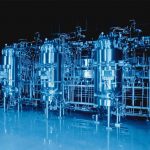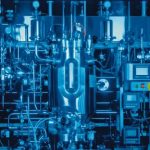The development of bioreactors has made crucial progress over the last few years. Nevertheless it is vital to adapt the reactors and their periphery to the constantly expanding scientific findings of cell culture research to be able to produce important drugs in appropriate quantity. Quick reaction to altered culture conditions and high stability of the composition of dissolved gasses and the pH are thereby especially important and can be achieved with Bioengineering’s aeration filter system.
The high shear sensitivity of animal and plant cells led to significant alterations in the construction of plants compared to bacterial fermenters. Since the gas supply of cells is dependent on the aeration and the agitation both systems must be adapted for cell culture. Adherent cells are cultivated on microcarriers either in the reactor or in a fixed bed. Therefore they are not directly accessible to shear stress.
The mechanical shear stress on non-adherent cells in submerged culture can be minimized either with marine impellers which provide a more gentle agitation than common blade stirrers, or with airlift-reactors where the agitation is achieved exclusively via the aeration. Sensitive cells are not only damaged by agitators but also by collapsing gas bubbles and foam. The simplest way to protect the cells from bubbles and foam is the addition of antifoam agents to the medium. But these chemical substances are unsuitable for a variety of cell types since they negatively influence the growth or metabolic functions essential for the manufacture of the product. In many cases they also significantly interfere with the downstream-processing. Therefore sparger systems were especially developed for cell culture, producing gas bubbles with minimum shear stress on the cells. With extremely sensitive cells bubble-free aeration can be achieved via gaspermeable hoses.
Gas composition
Not only the design of the aeration system but also the gas composition are often of vital significance for cell cultures. Especially plant cells adapt their metabolism to minor changes in the gas composition and thus alter the growth characteristics and the production of secondary metabolites. The aeration with oxygen enriched air leads to improved production results with many types of animal cells.
Unlike bacterial cultures which are aerated with air, cell cultures are aerated with oxygen, nitrogen, CO2 and air in a mixture optimized for each type of cell and fermentation. With the strict survey of the gas composition by sensitive control systems an optimum gas atmosphere should be created and maintained for the fermentation and the manufacture of the product.
During cell proliferation the pH of the medium alters. A constant pH is vital for many production processes and therefore it must be controlled. pH control is not effected with acid and bas dosage as with bacterial fermentations but via controlled addition of CO2.
Gas supply
The supply of the four gases used is normally effected with a gas mixing station. In this device the dosage of each gas is controlled individually by a gas flow controller. Additionally the pH-controller influences the dosage of CO2. A pO2-controller controls the aeration with air or oxygen and nitrogen. Thus optimum gas supply of the cells would be granted for every phase of the fermentation.
In cell culture technique it is essential to maintain absolutely sterile conditions because of the high contamination risk caused by the slow cell growth and the long fermentation times. Naturally this also applies to the gas supply. The gases used must not only be free of microorganisms but must not contain oil and dirt particles.
In small autoclavable fermenters autoclavable single use filters with hydrophobic PTFE membranes are used to sterilize the process gases and the exhaust air. These filters are autoclaved together with the fermenter. In situ sterilizable small fermenters and bigger plants utilize filter cartridges integrated in filter housings to ensure a sterile gas flow. Either filters with PTFE protected microfibres or membrane filters with synthetic PTFE-membrane are used. Depending on the reactor design filters and filter housings are either sterilized directly with the vessel or steamed independently in a defined sequence.
Gas demand
The oxygen level in liquid media is dependent on the amount of dissolved oxygen, of the oxygen in the gas phase above the medium and of the gas bubbles in the medium. Because of the reduced growth rates also the oxygen demand is lower than of bacterial cultures. Therefore the oxygen transfer rates (OTR) can also be lower, allowing low agitation speed and low aeration rates. The shear stress on the cells is thus minimized. Nevertheless the control of the gas composition is not jet achieved to full satisfaction in many cell fermentations.
Problems with the gas supply
With high gas flows and strong agitation as applied in bacterial cultures the length of the pipes the gases have to pass from the gas supply to the vessel is hardly relevant. The gases are distributed by the inlet pres-sure and agitation and thus reach the cells rapidly. The efficient supply of the required gases to plant and animal cells which are less aerated and agitated is not necessarily ensured at all times of the fermentation.
These cells tend to require a highly defined gas atmosphere and a stable pH more strongly than microorganisms. Therefore quick reaction to any change of these parameters is not only desirable but also necessary.
Long pathways of the gases and relatively high retention times in large filter housings could delay pH- and pO2-control in many cell cultures and thus lead to great losses in productivity. To counteract these effects basically three measures must be taken: a shortening of the pipes between gas mixing station and reactor, a reduction of the pipe diameters and a reduction of the dead volume of filters and filter housings. The first two alterations of the design are relatively unproblematic and depend on the plant geometry. But the adaption of filters and filter housings have caused problems in the past. The smallest dead legs and the shortest path for the gas flow provide the autoclavable single use filters which are used in autoclavable bench-top fermenters. These filters could not be sterilized with in situ sterilizable fermenters and therefore could not be fixedly integrated into the plant. If the filters are autoclaved separately and mounted to the plant after sterilization of the reactor, a source of contamination is created by this manipulation.
The solution of the problem
The solution as developed by Bioengineering is based on the utilization of single use filters with hydrophobic PTFE membrane and optimized dead legs also for in situ sterilizable systems. Thus the retention time of the gases in the filters is minimized. The gas retention during the passage through filter housings is avoided, since the new system simply dispenses with additional housings. Because of the small size of the filters the pipe diameters of the aeration lines can be kept low and the gas passage short.
But how can the incompatibility of autoclavable single use filters with in situ sterilizable fermenters be circumvented and at the same time the full integration of the filters in the plant be ensured?
In Bioengineering’s aeration system the single use filters for each of the four gases in the gas mixing station are located in an autoclav. This autoclav is integrated in the piping system of the plant and fitted with a viewing glass. A special set of valves which is steam permeable is mounted in the autoclav. The steam generated by the autoclav sterilizes the aeration line to a valve of the sterile cross. Then the pipe from the vessel to the sterile cross is sterilized in the course of the vessel sterilization. Air which could be trapped in the pipe is thus removed. The single used filters are automatically sterilized in the autoclav.
Thus the full integration of the autoclav and the filters into the plant is ensured. The automatic sterilization of the entire plant, including single use filters is rendered possible. No manipulations of the filters must be conducted after sterilization. This minimizes the contamination risk and ensures conformity with governmental regulations.
The advantages of the system are self-evident: not only cell cultures in small benchtop fermenters, but also in larger fermenters can be supplied with the required sterile gases in the shortest possible time. This creates fast control loops for pH- and pO2-control and therefore efficient response to all changes in the cell metabolism during the fermentation.
cpp 443
Bioengineering AG – Online dictionary
TechnoPharm 2007
Share:









